
Welcome
Introduction
Links and Refs
Standard Model
Accelerators
Relativity
Nobel Prizes
String Theory
Unification
Extra dimensions
Sociology
Duality
Internet
Branes
Duality
Black holes
M-Theory
Reactions
Mail me
Nobel Prizes
The Nobel comity has singled out a few individuals and given them a distinguished prize for their contribution to physics. Although we recall a few of the Nobel prizes that are closely linked to the physics discussed in other chapters, we pause to stress that physics is a product of a much larger social community. While it is easy, fun, motivating and popular to attach the name of a few geniuses to the most important developments in physics (and science), the larger community that shoulders the giants deserves equal, albeit anonymous, recognition.
Nobel
 The Nobel prize in physics
was first rewarded in 1901. It went to Roentgen, for his discovery of X-rays.
These are a form of electromagnetic waves with a very high frequency. In
other words, these waves consist of high energy photons. And Roentgen discovered
them first. (It is not too far fetched to compare his contribution to that
of the price winning trio Becquerel and the Curies.) In 1902, Lorentz got
the Nobel price, for his understanding of the electromagnetic force. He
described how charged particles behave in the presence of electromagnetic
fields. And Zeeman shared his price, for his understanding of the influence
electromagnetic fields have on the spectrum of atoms, i.e. on the frequencies
of photons radiated by atoms.
The Nobel prize in physics
was first rewarded in 1901. It went to Roentgen, for his discovery of X-rays.
These are a form of electromagnetic waves with a very high frequency. In
other words, these waves consist of high energy photons. And Roentgen discovered
them first. (It is not too far fetched to compare his contribution to that
of the price winning trio Becquerel and the Curies.) In 1902, Lorentz got
the Nobel price, for his understanding of the electromagnetic force. He
described how charged particles behave in the presence of electromagnetic
fields. And Zeeman shared his price, for his understanding of the influence
electromagnetic fields have on the spectrum of atoms, i.e. on the frequencies
of photons radiated by atoms.
In 1906 Thomson got the Nobel price for his discovery of the electrical unit of charge, as manifested in atoms. A year later Michelson got the price for his construction of the interferometer, an ingenious apparatus that allows, amongst others, a precise measurement of the (constant) speed of light.
A series of prices went to the inventors and developers of quantum mechanics.
In 1918 Planck got the price for his successful heuristic of quantised
energy packages, and Einstein got the price in 1921 for his explanation,
on the basis of Planck's hypothesis, of the photo-electric effect. Note
that he didn't get the price for his brilliant contributions to special
relativity, or for his formulation of general relativity.  Bohr was rewarded a year later for his theories on the structure of atoms,
and one year later Millikan for his discovery of the unit charge electron.
de Broglie (1929) won for stressing the wave nature of
Bohr was rewarded a year later for his theories on the structure of atoms,
and one year later Millikan for his discovery of the unit charge electron.
de Broglie (1929) won for stressing the wave nature of  the electron.
the electron.
Ten years later, in 1932 Heisenberg won the price for putting his predecessors
theories in a unified mathematical framework called quantum mechanics,
and the  next year Schroedinger
(photo) and Dirac were rewarded for further developing quantum mechanics
(and in particular for wave quantum mechanics and understanding anti-particles).
next year Schroedinger
(photo) and Dirac were rewarded for further developing quantum mechanics
(and in particular for wave quantum mechanics and understanding anti-particles).
In 1935 Chadwick got the price for the discovery of the neutron, and a year later Hess and Anderson for finding the positron in cosmic rays. It was predicted to exist by Dirac. Fermi won the race in 1938 with his theory of nuclear reactions, and a year later Lawrence was rewarded for inventing a particular kind of particle accelerator, the cyclotron. Stern won in 1943 for his discovery of the magnetic moment of the proton.
Pauli got the price for his discovery of the exclusion principle in
1945. His principle is a most important ingredient in our understanding
of the table of Mendeljev. In 1948 Blackett's cloud chamber (for keeping
track of particle trajectories after scattering) won, and a year later
Yukawa for his prediction of mesons (particles consisting of two bound
quarks), and another year later Powell, for finding them.  Born and Bothe's statistical interpretation of Schroedinger's wavefunction
was recognized in 1954, while Yang and Lee were rewarded for their analysis
of parity laws. Segre and Chamberlain (1959) found the anti-proton and
Glaser (1960) invented the bubble chamber. (...)
Born and Bothe's statistical interpretation of Schroedinger's wavefunction
was recognized in 1954, while Yang and Lee were rewarded for their analysis
of parity laws. Segre and Chamberlain (1959) found the anti-proton and
Glaser (1960) invented the bubble chamber. (...)
Check also the site of the Nobel committee itself for further fun information.